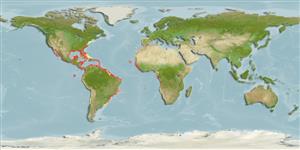分類 / Names
共通名の | 類義語 | Catalog of Fishes(部類, 種) | ITIS | CoL | WoRMS | Cloffa
板鰓亜鋼(サメとエイ類) (sharks and rays) >
Carcharhiniformes (Ground sharks) >
Carcharhinidae (Requiem sharks)
Etymology: Negaprion: negatus (L.), to deny; prion (Gr.), saw, referring to lack of saw-like serrations on teeth cusps (See ETYFish); brevirostris: brevis (L.), short; rostrum (L.), snout, referring to short, flat and broadly rounded snout (See ETYFish).
More on author: Poey.
Environment: milieu / climate zone / depth range / distribution range
生態学
海; 汽水性の 関連する礁; 海洋回遊性 (Ref. 51243); 深さの範囲 0 - 92 m (Ref. 244). Subtropical; 45°N - 33°S, 114°W - 14°E (Ref. 55192)
Western Atlantic: New Jersey, USA to southern Brazil, including the Gulf of Mexico, the Bahamas, and the Caribbean; also in Gulf of Mexico (Ref. 26938). Northeast Atlantic: Senegal, Côte d'Ivoire and probably wide-ranging off West Africa, but this requires confirmation. Eastern Pacific: southern Baja California, Mexico and the Gulf of California to Ecuador.
Length at first maturity / サイズ / 重さ / 年齢
Maturity: Lm ?, range 239 - ? cm
Max length : 340 cm TL オス/雌雄の選別がない; (Ref. 26938); common length : 240 cm TL オス/雌雄の選別がない; (Ref. 5217); 最大公表体重: 183.7 kg (Ref. 40637); 最大記録サイズ: 25 年 (Ref. 31395)
A brownish shark with yellow overtones but no conspicuous markings. Large second dorsal fin nearly same size as first dorsal (Ref. 26938).
Occurs on continental and insular shelves, frequenting mangrove fringes, coral keys, docks, sand or coral mud bottoms, saline creeks, enclosed bays or sounds, and river mouths. May enter fresh water. Occasionally moves into the open ocean, near or at the surface, apparently for purposes of migration. May rest motionless on the bottom (Ref. 9710). May occur singly or in small groups. Feeds mainly on fish but also takes crustaceans and mollusks. Viviparous, with 4 to 17 young in a litter. Size at birth 60 to 65 cm. Has been involved in several attacks on people. Meat is utilized for human consumption, hides for leather, fins for shark-fin soup base, liver oil for vitamins, and carcasses for fish meal. Marketed fresh, dried-salted and frozen (Ref. 9987).
Life cycle and mating behavior
成熟 | 繁殖 | 放精 | 卵 | 生産力 | 幼生
Distinct pairing with embrace (Ref. 205). Viviparous, placental (Ref. 50449), with 5 to 17 embryos (Ref. 9253). Both male and female during precopulatory and courtship swim with body axes in parallel (Ref. 49562, 51112). During copulation, the pair performs coordinated swimming (Ref. 49562, 51112).
Compagno, L.J.V., 1984. FAO Species Catalogue. Vol. 4. Sharks of the world. An annotated and illustrated catalogue of shark species known to date. Part 2 - Carcharhiniformes. FAO Fish. Synop. 125(4/2):251-655. Rome: FAO. (Ref. 244)
IUCNのレッドリストの状況は (Ref. 130435: Version 2024-2)
Human uses
水産業: 商業; ゲームフィッシュ: はい
用具
特記事項
XMLをダウンロードして下さい
インターネットの情報源
Estimates based on models
Preferred temperature (Ref.
123201): 21.9 - 28, mean 25.6 °C (based on 714 cells).
Phylogenetic diversity index (Ref.
82804): PD
50 = 0.7500 [Uniqueness, from 0.5 = low to 2.0 = high].
Bayesian length-weight: a=0.00513 (0.00270 - 0.00973), b=3.10 (2.94 - 3.26), in cm total length, based on LWR estimates for this species & (Sub)family-body (Ref.
93245).
栄養段階 (Ref.
69278): 4.3 ±0.5 se; based on diet studies.
Generation time: 9.2 ( na - na) years. Estimated as median ln(3)/K based on 1
growth studies.
回復力 (Ref.
120179): 非常に低い, 14年以上の倍増期間の最小個体群 (K=0.54(?); tm=12.7; tmax=25; Fec = 4-17; rmax = 0.012).
Fishing Vulnerability (Ref.
59153): High to very high vulnerability (73 of 100).
Climate Vulnerability (Ref.
125649): Very high vulnerability (76 of 100).
Nutrients (Ref.
124155): Calcium = 2.73 [0.51, 15.56] mg/100g; Iron = 0.307 [0.074, 0.937] mg/100g; Protein = 22.4 [20.0, 24.6] %; Omega3 = 0.145 [0.049, 0.381] g/100g; Selenium = 15.2 [4.5, 49.2] μg/100g; VitaminA = 29.7 [7.6, 116.9] μg/100g; Zinc = 0.449 [0.209, 0.900] mg/100g (wet weight);
